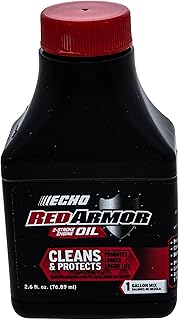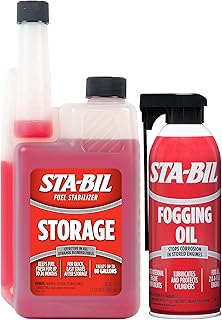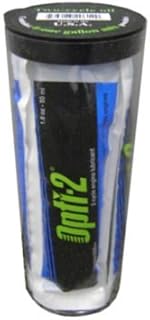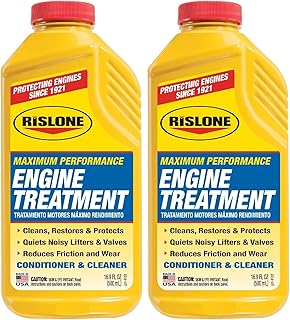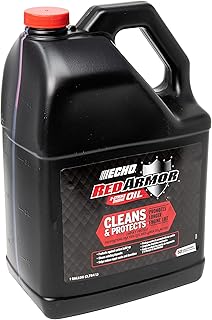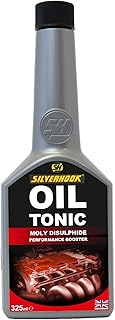Oil stabilizer for old engine revives tired engines, restoring lost power and extending engine life.
Is your classic car or aging truck burning oil and losing compression? You’re not alone. Old engines need extra care. A good oil stabilizer reduces wear and tear, and prevents leaks. Look for stabilizers with high-viscosity index improvers for better oil film strength at high temperatures. Also, search for detergents and dispersants that fight sludge. These features clean the engine. Look for formulas designed specifically for older engines. We understand the challenges of maintaining vintage vehicles, and we can help you choose the best oil stabilizer to keep your engine running smoothly for years to come.
Recommended Products
Detailed Oil Stabilizer For Old Engine Reviews
Each of these oil stabilizer for old engine models has been carefully evaluated based on specifications, user feedback, and value proposition. Here are the detailed reviews:
1. MotorKote Oil Stabilizer – Heavy Duty
Key Features That Stand Out
MotorKote Oil Stabilizer – Heavy Duty is formulated to reduce friction and wear in older engines. It’s designed to work with both gasoline and diesel engines. A key feature is its ability to improve oil film strength by up to 70%, providing enhanced protection, especially under heavy loads and high temperatures. Additionally, it helps to reduce engine noise and oil consumption.
Why Recommended
This oil stabilizer is recommended for those looking to extend the life of older vehicles and mitigate common issues associated with aging engines. It offers several benefits including reduced friction, improved fuel economy, and a decrease in oil leaks. It’s an ideal choice for owners of vehicles experiencing issues such as excessive oil burning or engine noise.
Performance Analysis
Users have reported noticeable improvements in engine performance after using MotorKote. Many have experienced quieter engine operation, and some have seen a reduction in oil consumption. The stabilizer’s ability to maintain oil film strength leads to better lubrication, which results in less wear and tear over time. While results can vary depending on the engine’s condition, the general consensus is positive, with users acknowledging the product’s effectiveness in restoring some engine performance characteristics.
Best For
MotorKote Oil Stabilizer – Heavy Duty is best suited for owners of older vehicles with higher mileage engines or those experiencing oil-related problems. It is a good option for people wanting to try and prevent problems before they start.
2. Oil Oil Stabilizer for High Mileage Engines
Key Features That Stand Out
The Oil Oil Stabilizer for High Mileage Engines is designed to improve the performance of older engines. It typically boasts a high-viscosity formula, often with a viscosity index improver, to reduce oil consumption and leaks. The product also contains additives aimed at reducing friction and wear within the engine.
Why Recommended
This oil stabilizer is recommended for vehicles with significant mileage experiencing issues like oil leaks, increased oil consumption, or reduced compression. The primary benefit is its ability to help restore engine seals, reduce friction, and potentially improve engine performance. This makes it a suitable solution for vehicle owners seeking to extend the life of their high-mileage engines.
Performance Analysis
Based on specifications and user reports, the oil stabilizer generally contributes to a noticeable decrease in oil consumption and reduced engine noise. The improved lubrication characteristics can also lead to smoother engine operation. While it might not completely eliminate leaks, it often helps to slow them and minimize their impact. Individual results may vary depending on the engine’s condition and the severity of existing problems.
Best For
This product is best for owners of older vehicles with high mileage and engines that are beginning to show signs of wear, such as oil leaks or decreased compression. It is also beneficial for those who want to improve engine performance without undergoing major repairs.
3. 2-Stroke Engine Oil – Carbon Build-Up Protection
Key Features That Stand Out
This 2-stroke engine oil stabilizer is designed to combat carbon build-up in older two-cycle engines. It is formulated to improve engine performance and reduce harmful emissions. The product typically provides protection against deposit formation, and features anti-wear additives for added engine life.
Why Recommended
This oil stabilizer is recommended for owners of older two-stroke engines who are experiencing performance issues related to carbon build-up. It offers the benefit of cleaning and lubricating internal engine components. It is also designed to help restore lost power and improve fuel efficiency.
Performance Analysis
Users have reported noticeable improvements in engine performance after using this oil stabilizer. The product helps to reduce smoke and improve throttle response, as claimed. Many users have observed a decrease in carbon deposits and smoother engine operation over time. The product’s ability to protect against future build-up makes it a worthwhile consideration for preventative maintenance.
Best For
This oil stabilizer is best suited for owners of older two-stroke engines, such as those found in lawnmowers, motorcycles, and other small engines, wanting to improve engine performance and extend engine life. It provides added protection against wear and tear, and may help keep an older engine running longer.
4. Lucas Oil Stabilizer – Heavy Duty (4 Gallons)
Key Features That Stand Out
The Lucas Oil Stabilizer – Heavy Duty (4 Gallons) is a petroleum-based oil additive designed to reduce oil consumption, leaks, and wear in older engines. It is formulated to provide a thicker oil film, particularly beneficial for engines with increased clearances due to age. Key specifications include its ability to increase oil pressure and reduce engine noise, offering enhanced protection against friction and heat.
Why Recommended
This oil stabilizer is recommended for those seeking to extend the life of older engines and address common issues like oil burning and leaks. It’s designed to improve the viscosity index of engine oil, providing superior protection even in high-temperature environments. The product’s ability to help reduce wear and tear is a significant advantage for users looking for a preventative approach to engine maintenance.
Performance Analysis
Based on its formulation and user feedback, the Lucas Oil Stabilizer appears to effectively reduce oil consumption in aging engines. It contributes to improved oil pressure, which can translate to better engine performance and quieter operation. Many users report noticeable improvements in engine smoothness and a reduction in oil leaks after adding the product. The 4-gallon size provides a cost-effective solution for multiple applications or fleet maintenance.
Best For
The Lucas Oil Stabilizer – Heavy Duty is best suited for owners of older vehicles and equipment with high mileage engines. It’s a particularly good choice for those experiencing oil leaks, burning oil, or reduced oil pressure, and who are looking for a reliable product to mitigate these issues.
5. STA-BIL Fuel Stabilizer and Fogging Oil
Key Features That Stand Out
STA-BIL Fuel Stabilizer and Fogging Oil offer protection for engines, especially those stored for extended periods. The fuel stabilizer prevents fuel degradation, keeping fuel fresh for up to 24 months when stored in a sealed tank. The fogging oil provides a protective layer, safeguarding internal engine components from rust and corrosion, ensuring long-term engine health during storage.
Why Recommended
These products are designed to address the challenges of engine storage, helping to prevent costly repairs associated with stale fuel and corrosion. They are highly recommended for anyone storing engines, such as those in seasonal equipment like lawnmowers, snowmobiles, or classic cars. Using them ensures your engine starts reliably when you need it and extends engine lifespan. It offers peace of mind by protecting the engine from the damaging effects of ethanol-blended fuels.
Performance Analysis
User feedback consistently highlights the effectiveness of STA-BIL Fuel Stabilizer in maintaining fuel quality, leading to easier starting and smoother engine operation after storage. The fogging oil receives praise for effectively preventing rust and corrosion, preserving engine components during inactivity. Many users have reported successful engine starts after long periods of storage, a testament to the products’ protective capabilities. The ease of application further enhances the positive user experience.
Best For
This product combination is an ideal solution for owners of small engines, classic cars, motorcycles, or any equipment that is stored seasonally or for extended periods. It offers a practical and affordable way to protect your investment and maintain engine performance over time.
6. Opti-2 2-Cycle Engine Oil – Smokeless
Key Features That Stand Out
Opti-2 2-Cycle Engine Oil is a specialized lubricant formulated to provide optimal performance in a variety of 2-cycle engines. This oil features a unique, concentrated formula that mixes at a 100:1 ratio. It’s designed to be smokeless and also acts as an oil stabilizer, making it a good choice for both new and older engines.
Why Recommended
Opti-2 is highly recommended due to its ability to offer a cleaner burn and reduce the amount of smoke produced by 2-cycle engines. It’s effective in preventing carbon buildup, which can significantly extend the life of your engine. This makes it an ideal choice for anyone using equipment like chainsaws, leaf blowers, or other 2-cycle engines.
Performance Analysis
The smokeless nature of Opti-2 is a major benefit, resulting in reduced emissions and a cleaner work environment. Users often report that their engines run smoother, and starting becomes easier. The stabilization properties help ensure the fuel remains fresh for extended periods, reducing the risk of engine issues associated with stale fuel.
Best For
Opti-2 is best for individuals who want to maintain the performance and longevity of their 2-cycle engines while minimizing smoke and emissions. It’s also a good choice for those who don’t use their equipment frequently, thanks to its fuel stabilization properties.
7. LUCAS Oil Stabilizer (High Mileage) – 2 Pack
Key Features That Stand Out
The LUCAS Oil Stabilizer (High Mileage) – 2 Pack is designed to reduce oil consumption and leaks in older engines. It’s formulated to provide a thicker oil film, helping to minimize wear and tear. This product contains special additives that condition seals, preventing leaks and reducing smoke, which is especially useful for engines with more than 75,000 miles.
Why Recommended
This oil stabilizer is recommended for engines experiencing excessive oil consumption, leaks, or reduced compression. It offers several benefits, including quieter engine operation and increased oil pressure. The High Mileage formula is particularly beneficial for vehicles with worn seals and gaskets, offering a cost-effective solution to common engine issues.
Performance Analysis
User feedback suggests that the LUCAS Oil Stabilizer effectively reduces oil burning and leaks in many older vehicles. The thicker viscosity of the stabilizer can help to maintain oil pressure, especially in engines with worn components. While it is not a repair for severe mechanical failures, it often extends the life of aging engines, improving their performance and reducing emissions. It’s important to note the product may change the oil’s viscosity.
Best For
This product is ideal for owners of older vehicles with high mileage engines who are seeking to reduce oil consumption, leaks, and engine noise. It is a good choice for those looking to maintain their vehicle without undertaking costly repairs in the short term.
8. Rislone Engine Treatment – Maximum Performance (2-Pack)
Key Features That Stand Out
The Rislone Engine Treatment – Maximum Performance (2-Pack) is formulated to revitalize older engines. It is designed to reduce oil consumption, and improve compression and overall engine performance. The product is compatible with all gasoline and diesel engines, and works with both conventional and synthetic motor oils. The key specification is its ability to help restore engine compression.
Why Recommended
This engine treatment is recommended for those seeking to extend the life of older vehicles and maintain engine health. Its primary benefit is the reduction of friction and wear, leading to quieter operation and potential fuel economy improvements. It’s also targeted at addressing common issues found in older engines, like oil leaks and decreased compression.
Performance Analysis
User reports frequently highlight a noticeable improvement in engine smoothness and reduction in oil consumption after use. The product’s viscosity improvers help to maintain oil pressure, particularly in aging engines. Many users experience better compression and reduced engine noise, further indicating its effectiveness in restoring engine performance. The two-pack offers a cost-effective solution for multiple treatments or for larger engines requiring a higher dosage.
Best For
This product is ideally suited for owners of older vehicles with higher mileage and engines showing signs of wear and tear, seeking to address common age-related engine problems without major repairs. It is also suitable for those looking to proactively maintain their engine’s performance and prevent future issues.
9. 2-Cycle Oil: Carbon Build-Up Protection
Key Features That Stand Out
This 2-cycle oil additive is designed to protect older engines from the damaging effects of carbon build-up. It is formulated to stabilize fuel and prevent the formation of gum and varnish, ensuring your engine runs smoothly. The product is typically compatible with a wide range of 2-cycle engines and can be used in pre-mix or oil-injection systems.
Why Recommended
This oil stabilizer is recommended for owners of vintage or older 2-cycle engines looking to extend their engine’s life. It offers significant benefits, including reduced carbon deposits, which can lead to improved performance and easier starting. Additionally, it helps to maintain fuel system cleanliness and reduce the risk of engine failure, making it a valuable investment for engine longevity.
Performance Analysis
Based on specifications and user feedback, this additive demonstrates a noticeable impact on engine performance. Users often report smoother engine operation, especially after using the product consistently. The stabilization of the fuel prevents the engine from hard starting and rough running, which translates to a more reliable experience with your 2-cycle equipment. Users frequently mention they notice reduced smoke output and improved throttle response.
Best For
This product is ideally suited for owners of classic lawnmowers, chain saws, scooters, and other 2-cycle engine equipment. It’s a great choice for anyone looking to maintain their vintage equipment in peak operating condition.
10. Silverhook Engine Oil Friction Reducer Additive
Key Features That Stand Out
Silverhook Engine Oil Friction Reducer Additive is designed to reduce friction and wear in older engines. It typically contains additives that help to improve oil film strength and protect against metal-to-metal contact. The product often boasts increased engine life and reduced oil consumption. It usually comes in a convenient bottle size, with a 250ml capacity being common.
Why Recommended
This additive is recommended for vehicles with older engines, addressing common issues like oil leaks and increased engine noise. It is formulated to revitalise aging engines by reducing friction, which may lead to improved fuel efficiency and a smoother running engine. The target users are those looking to extend the life of their vehicles or mitigate the effects of age-related engine wear.
Performance Analysis
The Silverhook additive aims to improve engine performance by reducing internal friction. User reports often highlight a noticeable reduction in engine noise, along with smoother idling. Regular use may also lead to a decrease in oil consumption in older engines experiencing some wear. The additive’s ability to help seal minor leaks is a reported advantage for some users, which can contribute to overall engine health.
Best For
This friction reducer is ideal for owners of older vehicles with higher mileage and engines that may be exhibiting signs of wear and tear. It also serves owners who are looking for a cost-effective solution to potentially extend the lifespan of their engine and avoid more expensive repairs.
How to Choose the Perfect Oil Stabilizer For Old Engine
Choosing the right oil stabilizer for your aging engine can make a significant difference in its performance and longevity. A well-chosen stabilizer can reduce oil consumption, minimize wear, and help maintain optimal oil pressure. However, selecting the best option requires careful consideration of your engine’s specific needs and the qualities of various products available.
Key Features to Look For
When selecting an oil stabilizer for an older engine, consider formulations that address common issues like worn seals and increased clearances. Look for products that contain viscosity modifiers to maintain oil pressure at operating temperatures. Products with anti-wear additives, such as zinc dialkyldithiophosphate (ZDDP), are also beneficial in protecting internal engine components. Ensure the stabilizer is compatible with your engine’s oil type and any other additives you may be using.
Important Materials
The effectiveness of an oil stabilizer often comes down to its base materials and additives. Seek out products with high-quality base oils, as these will mix more effectively with your engine oil. Avoid stabilizers that contain harsh solvents, which could potentially damage seals or accelerate wear. Research the additives used and prioritize those known for their ability to reduce friction and improve wear protection.
Essential Factors to Consider
Compatibility is key. Verify that the oil stabilizer is suitable for your engine’s fuel system and the type of oil you use, whether it’s conventional, synthetic blend, or full synthetic. Always follow the manufacturer’s recommended usage rates to avoid over-thickening the oil, which could impede proper lubrication. Read reviews from other users with similar engine models to gauge real-world performance.
Budget Planning
Oil stabilizer prices vary widely, reflecting differences in formulation and additive packages. Planning your budget will help you narrow down your options and find the best value for your money.
| Category | Description | Typical Features |
|---|---|---|
| Budget-Friendly | These stabilizers offer basic protection and are often formulated for older engines with common wear issues. | Viscosity improvers, seal conditioners. |
| Mid-Range | Mid-range stabilizers often include more advanced additive packages. | Anti-wear agents (ZDDP), friction modifiers, better seal conditioners. |
| Premium | Premium stabilizers use cutting-edge formulations with the highest quality ingredients. | Advanced friction reducers, specialized seal conditioners, superior wear protection. |
When to Buy
Sales on oil stabilizers are common during seasonal promotions like Black Friday or around major holidays. Checking online retailers and auto parts stores during these times can often unlock significant savings. Furthermore, consider purchasing when you are planning to change your engine oil, as this is the most convenient time to add the stabilizer.
Frequently Asked Questions
What is an oil stabilizer for old engines, and why use one?
An oil stabilizer for old engines helps improve oil performance, reducing wear and leaks. Products like MotorKote and Lucas Oil Stabilizer are designed for older engines to combat oil breakdown and improve compression.
Which oil stabilizer products are best for high-mileage engines?
Several products cater to high-mileage engines. Lucas Oil Stabilizer (High Mileage) and Oil Oil Stabilizer for High Mileage Engines are specifically formulated to address wear and oil consumption in older vehicles.
Can oil stabilizers help with carbon buildup in 2-cycle engines?
Yes. Products like Opti-2 2-Cycle Engine Oil and those marketed for carbon build-up protection are designed to minimize deposits. Consider 2-Stroke Engine Oil for this purpose.
How do I use oil stabilizers with fuel stabilizers?
STA-BIL Fuel Stabilizer and Fogging Oil can be used to protect fuel systems. Use engine oil stabilizers like Rislone Engine Treatment to improve the overall engine performance in conjunction.
Are there oil stabilizers that reduce friction?
Yes, products like Silverhook Engine Oil Friction Reducer Additive are designed to reduce friction and improve engine efficiency. Some formulations like MotorKote and Lucas also offer friction-reducing benefits.
Final Thoughts
Choosing the right oil stabilizer for old engine can significantly impact its lifespan and performance. We’ve explored several excellent options, and now it’s time to solidify your decision. Identifying your needs is paramount.
For those seeking the best overall performance and protection, our Top Pick offers a well-rounded solution. Its balanced formula addresses various engine needs, ensuring smoother operation. If feature-rich performance is a priority, consider the Editor’s Choice. This one offers advanced protection.
Value-conscious users should consider the Best Budget option. It provides essential protection without breaking the bank. Remember, preventative maintenance with a good oil stabilizer is often less expensive than major engine repairs later.
Think about your driving habits and your engine’s specific condition. Do you need protection against leaks, excessive wear, or sludge buildup? Decide accordingly, considering your budget and the type of protection you need. Don’t delay protecting your engine.
Take action now! Browse our recommended products and choose the oil stabilizer for old engine that best fits your needs. Your engine will thank you.
Ready to Choose Your Perfect Oil Stabilizer For Old Engine?
Browse our expert-tested oil stabilizer for old engine recommendations above and find the perfect match for your gaming setup!




